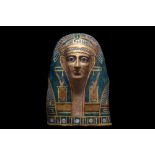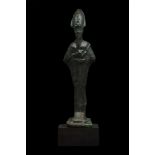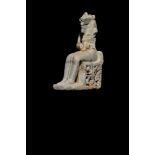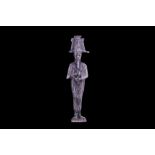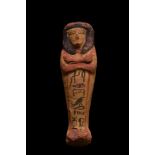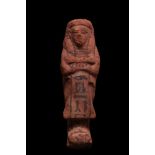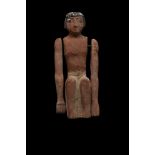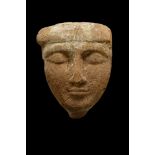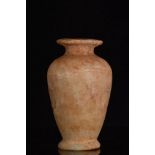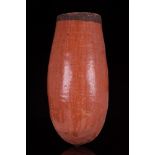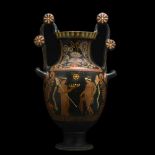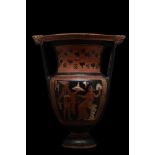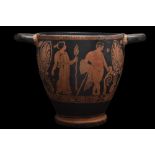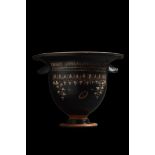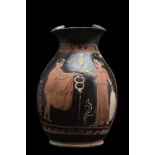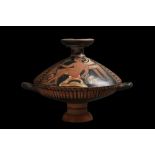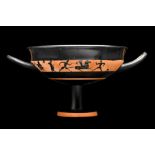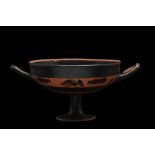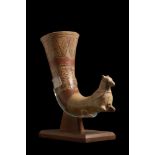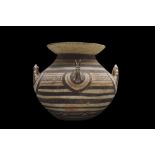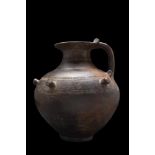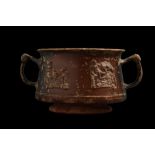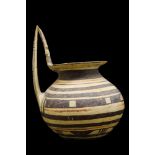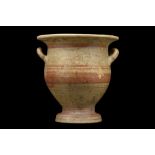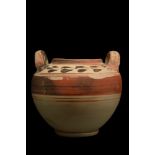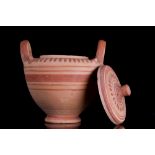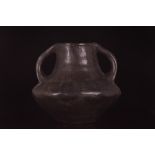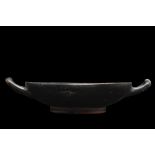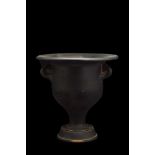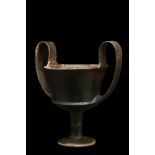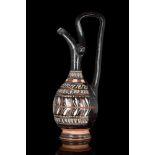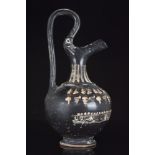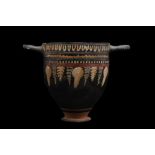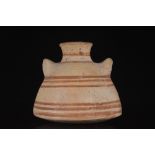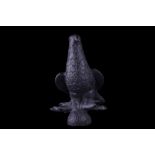Filtered by:
- Show only bulk lots,
- Category
- List
- Grid
A subscription to the Price Guide is required to view results for auctions ten days or older. Click here for more information
Ptolemaic Period, Ca. 332-30 BC. An ancient Egyptian cartonnage mask of timeless beauty depicting the deceased who is shown wearing a tripartite w...
Late Dynastic Period, Saite Period. Egyptian, Ca. 664-332 BC. A bronze figure of Osiris standing mummiform with his hands emerging from his cloak,...
Late Period - Ptolemaic Dynasty, c. 663-30 BC. Statuette of the war god Maahes enthroned on a modern stand. His leonine head is adorned with a nem...
Late Period, 26th Dynasty, Ca. 664-525 BC. A silver votive figurine of Osiris wearing an atef crown, plumed on each side with ostrich feathers and...
New Kingdom, 19th - 20th Dynasty, Ca. 1292-1085 BC. A well-moulded terracotta ushabti, wearing the tripartite wig, holding hoe and mattock, basket...
New Kingdom, 19th-20th Dynasty, Ca. 1292-1085 BC. A terracotta ushabti figure modelled in stylised mummiform pose with hands crossed over the ches...
Middle Kingdom,11th - 13th Dynasty, (Ca. 2345-2181 B.C.). An ancient Egyptian boatman funerary figure carved from a single piece of cedar wood in ...
Late Dynastic Period, Ca. 664-32 BC. A carved sarcophagus mask formed from a finely grained cedar wood. The countenance presents with bulging almo...
EGYPTIAN ALABASTER JAR
New Kingdom, Ca. 1550-1070 BC. The vessel of piriform shape smoothly tapers to a narrow flat base, standing on an everting foot, with a short cyli...
Ca. 2050-1786 BC. A beautifully modelled cylindrical vessel of alabastron form, the cylindrical body tapering to the pointed base, the plain rim p...
Ca. 400 BC. A large and impressive red-figure painted terracotta vessel, standing on a pedestal foot, having two opposing handles at the shoulder,...
Ca. 350-300 BC. A large and superb Apulian pottery Column krater with a decorative frame. From right to left, on the A-side a scene of a seated dr...
VERY LARGE APULIAN SKYPHOS
Ca. 370-360 BC. A very sizeable and attractive red-figure painted skyphos (wine cup), depicting (on side A) a winged nude Eros in profile, riding ...
Ca 4th century BC. Of imposing size, this bell-krater is decorated with colourful program in red, yellow, and white pigments against black glossy ...
APULIAN RED-FIGURE OINOCHOE
Attributable to the Iliupersis Painter, Ca. 370-350 BC. An attractive blackware oinochoe with a nicely delineated foot, a rotund body, a cylindric...
Ca. 350-300 BC. Beautifully painted, lidded lekanis of typically elegant form, the shallow bowl painted in black, standing on a stemmed foot and w...
Ca. 500-400 BC. A beautiful Attic pottery kylix decorated via the black-figure technique on the exterior walls of both sides, hemispherical body w...
Ca. 540-525 BC. A beautiful pottery kylix decorated via the black-figure technique on the exterior walls of both sides, hemispherical body with tw...
Ca. 1st millennium BC. A terracotta rhyton with a flaring lip, and a conical shaped body terminated into a equine finial; the trumpet-shaped both ...
Ca. 400 BC. A very rare example of a ceramic krater with a deep funnel-shaped neck, twin loop handles on the shoulder, and between each handle a v...
VILLANOVAN POTTERY VESSEL
Ca. 700-600 BC. A one-handled pottery vessel of a wide, globular body on a flat ring foot. The shoulder is broad, with two bands of incised decora...
Late Hellenistic, Ca. 100 BC. The two-handled vessel on a splayed foot, with a flaring rim and twin handles with circular bosses, with four, appli...
Ca. 200 AD. A finely carved in extremely high relief – virtually in the round – section of a marble sarcophagus depicting the god Eros (Roman Cupi...
Ca. 400-500 AD. A Late Roman bronze jug rising from a flared short foot. The vessel features an inverted piriform lower body with ribbing features...
Ca. 300-400 AD. A bronze jug with a flaring step rim, restricted neck, piriform body, and a long figural handle with a plate in the form of a head...
Ca. 200 AD. A silver kylix with a hemispherical bowl resting on a concave foot and two equally spaced loop handles. Decorated on the exterior with...
Ca. 100-300 AD. A rock crystal intaglio bearing an engraved gryllos motif, comprising a bust of left-facing Minerva wearing a plumed helmet, and t...
Ca. 100-200 AD. An oval rock crystal intaglio depicting a right-facing female bust, flanked by quiver and arrows. The latter led to identifying th...
New Kingdom period, Ca. 1292 -1077 BC, 19th - 20th Dynasty, Ramesside Period. A mummiform ushabti formed of painted pottery is wearing a bipartite...
Late Dynastic Period, Ca. 664-332 BC. A pale turquoise faience Egyptian ushabti modelled with a tripartite wig and false beard. His arms are cross...
Ca. 664-525 BC. An ancient Egyptian funerary statuette with a mummy shaped body and back pillar standing on a small base plate. Modelled details, ...
Late Dynastic Period, Ca. 664-332 BC. A mummiform figure in the form of an ushabti, moulded in a light-blue, glazed faience, wearing a tripartite ...
Early Third Intermediate Period, Ca.1070-945 BC. A mummiform ushabti wearing a pain tripartite wig and a divine beard. The front lappets of the wi...
ANCIENT EGYPTIAN FAIENCE USHABTI
Late Dynastic Period, Ca. 664-332 BC. An ancient Egyptian blue faience ushabti. The mummiform figurine wears a tripartite wig, his crossed hands h...
EGYPTIAN FAIENCE USHABTI
Ptolemaic Period, Ca. 323 BC. An ancient Egyptian faience mummiform ushabti wearing a plain tripartite wig and plaited divine beard. The wig is wo...
EARLY EGYPTIAN MARBLE VESSEL
Thinite Period, 1st-2nd Dynasty, Ca. 3100-2700 BC. An early marble vessel in piriform amphora-like shape which widens towards the neck with two ce...
EGYPTIAN AMULET OF BES
Late Period, Ca. 663-323 BC. Blue glazed faience amulet of the dwarf god Bes. Plumed headdress containing a suspension hole, a gnarling, somewhat-...
EGYPTIAN BEADED FUNERARY MASK
Late Period, Ca. 663-323 BC. An ancient Egyptian mummy shroud of beadwork from the chest of a mummified person, consisting of a net of dark green ...
Late Period, Ca. 664-332 BC. An ancient Egyptian mummy shroud of beadwork from the chest of a mummified person, consisting of a net of dark green ...
Late Dynastic / Ptolemaic Egyptian, Ca. 664-343 BC . A beaded mummy mask made of delicate faience beads in green, white, yellow, black, and red. T...
ETRUSCAN VOTIVE POTTERY FOOT
Ca. 700-500 BC. A salmon color pottery votive foot, depicted with simplified toes. Overall scattered mineral deposits and areas of surface encrust...
Apulian, Ca. 350-300 BC. A rare red-figure kantharos. This tall stemmed cup has two sweeping high handles and a gently flared body that sits on a ...
Ca. 350 BC. A lovely Daunian kyathos with a bulbous body tapering to a flat base. Narrowed neck leading to a broad, flat rim. A high strap handle ...
Ca. 400 BC. A finely modelled wheel-thrown bichrome terracotta bell krater of a classic form with a flared rim and twin upraised coil-built handle...
Ca. 400-300 BC. A Messapian lebes gamikos, a delicately formed "marriage vase" with an inverted bell-shaped body and its characteristic pair of ho...
DAUNIAN LEBES GAMIKOS
Ca. 4th century BC. A Daunian lebes gamikos - "marriage vase" with an inverted bell-shaped body and its characteristic pair of horizontal strap ha...
VILLANOVAN BLACKWARE IMPASTO JAR
Ca. 1100-700 BC. A well-formed blackware jar with twin symmetrical handles rising from the shoulder. The Villanovan culture is known mostly for th...
Ca. 400-300 BC. A stemless terracotta Greek kylix (drinking cup), covered in a rich black gloss. The large, shallow body rests on a low foot that ...
Ca. 400-300 BC. A magnificent Campanian terracotta bell krater, executed in black slip. The vessel presents a pedestal base, bell-shaped body, app...
Ca. 400-300 BC. Greek black-glazed kantharos with high attenuated twin handles and a high stemmed foot with a raised ridge. Lovely hints of irides...
Ca. 400 BC. A delicate, well detailed vessel known as a prochous, formed in a black-glazed, crafted with a tall bulbous body tapering into shaped ...
GREEK GNATHIAN POTTERY PROCHOUS
Ca. 4th century BC. A pouring vessel known as a prochous, wheel-thrown and decorated with a lustrous black glaze. The vessel is defined by its dis...
Ca. 2nd half of the 4th - 1st half of the 3rd Century BC. A particularly nice and well-preserved example of a typical drinking cup from Southern I...
PALAEO-MYCENAEAN PYXIS
Late Bronze Age, Ca.1300 BC. A pyxis in buff terracotta; twin lug handles on the shoulders for suspension (suspension would help in evaporation of...
Ca. 100-200 AD. A cast bronze figurine of an eagle perching on an integral stand. Expertly cleaned and conserved, with a smooth patina. An aquila ...
ROMAN SILVER COCHLEAR SPOON
Ca. 100-300 AD. A solid silver spoon with a wide bowl attached to a long round-section handle finished with a pointed finial for use in extracting...
ROMAN SILVER BOWL
Ca. 100-300 AD. An outstanding silver bowl with a slightly rounded base, straight rim and a broad, deep body. Bowls of this kind were used for pou...
ROMAN SILVER BOWL
Ca.100-300 AD. A silver wine bowl with a hemispherical body and smooth walls. Banqueting was a major part of the aristocratic culture in antiquity...
Ca. 1200-800 BC. A hammered-bronze vessel of a wide, circular form with its walls gently tapering to a flat base. The mid-section is adorned with ...
RARE ROMAN POTTERY SKYPHOS
Ca. 100 BC - 100 AD. The mold-made body is decorated with a pine-cone or petal-like motif, with a smooth foot, rim, and the ribbed ring handles ea...

